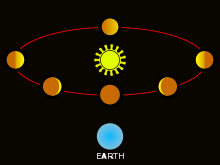Astronomy college course/Lunar Phases
All planet exhibit phases as seen from Earth. For example, Galileo's discovery that Venus showed phases (while remaining near the Sun in our sky) was strong evidence that it orbits the Sun and not the Earth. While Copernicus didn't have a telescope, he used the varying brightness of Mars to argue that it also orbited the Sun.


Phases of the moon
editThe diagram below to the right shows a 'top down' view of the earth-moon system, as seen from above the north pole. This model ignores that tilt of Earth's rotational axis, and assumes that the Earth, Sun, and Moon all lie in the same plane. Such a model would fail miserably in modeling eclipses, but serves quite well for understanding the monthly cycle of lunar phases.
Direction of rotation and revolution
editMost objects in the solar system tend to rotate and revolve in roughly the same direction. The black arrows depict the rotation of Earth about its axis (as seen from above the north pole). To remember it, put your right hand on table and your fingers indicate this rotation. The Moon also revolves in the same direction. To verify this, find the 'new moon' and notice that a quarter of a cycle later the moon is at 'first quarter'. Then after the full moon, it enters 'third quarter', after which the cycle begins with another 'new moon'. As we shall see in the next section, the black arrow also depicts the direction 'east'.
A view from 6 PM
editAssume that you are standing somewhere near the equator. It is easiest to begin with 6 PM because that places you on top of the the blue circle. The direction 'up' (called zenith)is opposite the direction 'down' (nadir) that points to the center of the earth. At 6 PM, you would see the first quarter moon directly overhead, if the moon is in that phase on that day. If the moon is full, you would see it in a direction perpendicular to the up/down direction. In other words, the full moon would on the horizon at 6PM. The sun is at the other horizon (where it always appears at 6 PM.) The black arrows always represent east. Like time, the concept of east and west depends on where you are situated on earth.
A view from midnight
editThe observer's version of 'up' (zenith) is counter-intuitive if it is not 6 PM because the observer's 'up' does not match zenith from your perspective. At midnight, zenith points to your left, where you would see the full moon if it is in that phase. If the moon is in first quarter, you would see it along the horizon. That is obvious from the figure. But is the eastern or western horizon? It is on the western horizon, and there are two ways to prove it:
- The black arrow (east) points towards the bottom of your computer screen (or page) at midnight. The first quarter moon is opposite, or in the west.
- West is where objects fall below the horizon. As the earth brings you from midnight into 3 AM, the first quarter moon will sink below the horizon.